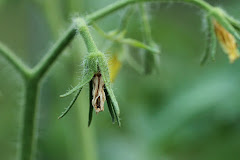The use of mulches now has several benefits. It will blunt the force of hard summer rains minimizing crusting and soil compaction. Mulch slows evaporation and can reduce irrigation needed by 25 to 50 percent. Stabilizing soil moisture to avoid wide swings from wet to dry promotes better quality vegetables and encourages the activity of beneficial soil organisms. Mulches applied now tend to keep soil temperatures cooler during summer and suppress weed seed germination.
 Weed and seed-free straw (left) and grass clippings make some of the best mulches. Wood mulches are not recommended around vegetable plants, only for paths in the garden. Collect grass clippings from lawns that have not been treated with herbicides (“weed killers”) for at least a month.
Weed and seed-free straw (left) and grass clippings make some of the best mulches. Wood mulches are not recommended around vegetable plants, only for paths in the garden. Collect grass clippings from lawns that have not been treated with herbicides (“weed killers”) for at least a month.
Apply a thin layer of grass clippings (right) which will dry in five to seven days (below), then add the next layer. Two to three layers is generally enough to suppress weeds. Do not add thick layers which will mat, smell and limit water and air movement into the soil. Carefully apply around leafy vegetables as grass clippings are difficult to wash from the leaves and heads of greens.
 Both straw and grass clippings can be tilled under in the fall and easily break down to enrich the soil. If straw isn’t desired for tilling under due to appearance, it can be raked off and placed in the compost bin.
Both straw and grass clippings can be tilled under in the fall and easily break down to enrich the soil. If straw isn’t desired for tilling under due to appearance, it can be raked off and placed in the compost bin.Straw and grass clipping mulch photo credit: Carl Wilson









